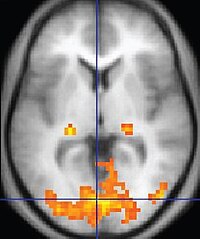
Photo from wikipedia
Functional magnetic resonance imaging (fMRI) has revolutionized the investigation of brain function. Similar approaches can be translated to probe spinal mechanisms. However, imaging the spinal cord remains challenging, notably due… Click to show full abstract
Functional magnetic resonance imaging (fMRI) has revolutionized the investigation of brain function. Similar approaches can be translated to probe spinal mechanisms. However, imaging the spinal cord remains challenging, notably due to its size and location. Technological advances are gradually tackling these issues, though there is yet no consensus on optimal acquisition protocols. In this study, we assessed the performance of three sequences during a simple motor task and at rest, in 15 healthy humans. Building upon recent literature, we selected three imaging protocols: a sequence integrating outer volume suppression (OVS) and two sequences implementing inner field-of-view imaging (ZOOMit) with different spatial and temporal resolutions. Images acquired using the OVS sequence appeared more prone to breathing-induced signal fluctuations, though they exhibited a higher temporal signal-to-noise ratio than ZOOMit sequences. Conversely, the spatial signal-to-noise ratio was higher for the two ZOOMit schemes. In spite of these differences in signal properties, all sequences yielded comparable performance in detecting group-level task-related activity, observed in the expected spinal levels. Nevertheless, our results suggest a superior sensitivity and robustness of patterns imaged using the OVS acquisition scheme. To analyze the data acquired at rest, we deployed a dynamic functional connectivity framework, SpiCiCAP, and we evaluated the ability of the three acquisition schemes to disentangle intrinsic spinal signals. We demonstrated that meaningful subdivisions of the spinal cord's functional architecture could be uncovered for all three sequences, with similar spatio-temporal properties across acquisition parameters. Cleaner and more stable components were, however, obtained using ZOOMit sequences. This study emphasizes the potential of fMRI as a robust tool to image spinal activity in vivo and it highlights specificities and similarities of three acquisition methods. This represents a key step towards the establishment of standardized spinal cord fMRI protocols.
Journal Title: NeuroImage
Year Published: 2022
Link to full text (if available)
Share on Social Media: Sign Up to like & get
recommendations!